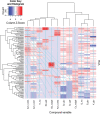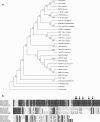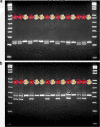An R2R3 MYB transcription factor determines red petal colour in an Actinidia (kiwifruit) hybrid population
- PMID: 23324587
- PMCID: PMC3618344
- DOI: 10.1186/1471-2164-14-28
An R2R3 MYB transcription factor determines red petal colour in an Actinidia (kiwifruit) hybrid population
Abstract
Background: Red colour in kiwifruit results from the presence of anthocyanin pigments. Their expression, however, is complex, and varies among genotypes, species, tissues and environments. An understanding of the biosynthesis, physiology and genetics of the anthocyanins involved, and the control of their expression in different tissues, is required. A complex, the MBW complex, consisting of R2R3-MYB and bHLH transcription factors together with a WD-repeat protein, activates anthocyanin 3-O-galactosyltransferase (F3GT1) to produce anthocyanins. We examined the expression and genetic control of anthocyanins in flowers of Actinidia hybrid families segregating for red and white petal colour.
Results: Four inter-related backcross families between Actinidia chinensis Planch. var. chinensis and Actinidia eriantha Benth. were identified that segregated 1:1 for red or white petal colour. Flower pigments consisted of five known anthocyanins (two delphinidin-based and three cyanidin-based) and three unknowns. Intensity and hue differed in red petals from pale pink to deep magenta, and while intensity of colour increased with total concentration of anthocyanin, no association was found between any particular anthocyanin data and hue. Real time qPCR demonstrated that an R2R3 MYB, MYB110a, was expressed at significant levels in red-petalled progeny, but not in individuals with white petals.A microsatellite marker was developed that identified alleles that segregated with red petal colour, but not with ovary, stamen filament, or fruit flesh colour in these families. The marker mapped to chromosome 10 in Actinidia.The white petal phenotype was complemented by syringing Agrobacterium tumefaciens carrying Actinidia 35S::MYB110a into the petal tissue. Red pigments developed in white petals both with, and without, co-transformation with Actinidia bHLH partners. MYB110a was shown to directly activate Actinidia F3GT1 in transient assays.
Conclusions: The transcription factor, MYB110a, regulates anthocyanin production in petals in this hybrid population, but not in other flower tissues or mature fruit. The identification of delphinidin-based anthocyanins in these flowers provides candidates for colour enhancement in novel fruits.
Figures









Similar articles
-
Overexpression of the kiwifruit SVP3 gene affects reproductive development and suppresses anthocyanin biosynthesis in petals, but has no effect on vegetative growth, dormancy, or flowering time.J Exp Bot. 2014 Sep;65(17):4985-95. doi: 10.1093/jxb/eru264. Epub 2014 Jun 19. J Exp Bot. 2014. PMID: 24948678 Free PMC article.
-
Chalcone Synthase-Encoding AeCHS is Involved in Normal Petal Coloration in Actinidia eriantha.Genes (Basel). 2019 Nov 20;10(12):949. doi: 10.3390/genes10120949. Genes (Basel). 2019. PMID: 31757002 Free PMC article.
-
Kiwifruit R2R3-MYB transcription factors and contribution of the novel AcMYB75 to red kiwifruit anthocyanin biosynthesis.Sci Rep. 2017 Dec 4;7(1):16861. doi: 10.1038/s41598-017-16905-1. Sci Rep. 2017. PMID: 29203778 Free PMC article.
-
Advance of the negative regulation of anthocyanin biosynthesis by MYB transcription factors.Plant Physiol Biochem. 2019 Mar;136:178-187. doi: 10.1016/j.plaphy.2019.01.024. Epub 2019 Jan 22. Plant Physiol Biochem. 2019. PMID: 30685697 Review.
-
Genome-wide identification of Pistacia R2R3-MYB gene family and function characterization of PcMYB113 during autumn leaf coloration in Pistacia chinensis.Int J Biol Macromol. 2021 Dec 1;192:16-27. doi: 10.1016/j.ijbiomac.2021.09.092. Epub 2021 Sep 20. Int J Biol Macromol. 2021. PMID: 34555399 Review.
Cited by
-
Purple foliage coloration in tea (Camellia sinensis L.) arises from activation of the R2R3-MYB transcription factor CsAN1.Sci Rep. 2016 Sep 1;6:32534. doi: 10.1038/srep32534. Sci Rep. 2016. PMID: 27581206 Free PMC article.
-
Comprehensive Transcriptome Profiling Reveals Long Noncoding RNA Expression and Alternative Splicing Regulation during Fruit Development and Ripening in Kiwifruit (Actinidia chinensis).Front Plant Sci. 2016 Mar 29;7:335. doi: 10.3389/fpls.2016.00335. eCollection 2016. Front Plant Sci. 2016. PMID: 27594858 Free PMC article.
-
Integrated transcriptome and metabolome profiling of Camellia reticulata reveal mechanisms of flower color differentiation.Front Genet. 2022 Nov 22;13:1059717. doi: 10.3389/fgene.2022.1059717. eCollection 2022. Front Genet. 2022. PMID: 36482888 Free PMC article.
-
Roles of R2R3-MYB transcription factors in transcriptional regulation of anthocyanin biosynthesis in horticultural plants.Plant Mol Biol. 2018 Sep;98(1-2):1-18. doi: 10.1007/s11103-018-0771-4. Epub 2018 Aug 30. Plant Mol Biol. 2018. PMID: 30167900 Review.
-
Expression Differences of Pigment Structural Genes and Transcription Factors Explain Flesh Coloration in Three Contrasting Kiwifruit Cultivars.Front Plant Sci. 2017 Sep 1;8:1507. doi: 10.3389/fpls.2017.01507. eCollection 2017. Front Plant Sci. 2017. PMID: 28919902 Free PMC article.
References
-
- Gould K, Lister C. In: Flavonoids: Chemistry, Biochemistry, and Applications. Andersen OM, Markham K, editor. Boca Raton, Florida: CRC Press; 2006. Flavonoid functions in plants; pp. 397–411.
-
- de Pascual-Teresa S, Sanchez-Ballesta MT. Anthocyanins: from plant to health. Phytochem Rev. 2008;7:281–299. doi: 10.1007/s11101-007-9074-0. - DOI
Publication types
MeSH terms
Substances
LinkOut - more resources
Full Text Sources
Other Literature Sources

